Did you know the anime and manga industry is a big deal worldwide? It’s worth billions. Every month, millions of people watch thousands of hours of anime. This makes these art forms a key part of global culture.
Key Takeaways:
- The anime and manga industry is worth billions of dollars globally.
- Anime has gained widespread popularity and has become mainstream entertainment.
- Tezuka’s manga Astro Boy aimed to teach children about civil rights and injustices.
- Japan’s manga and anime industries have a significant economic impact.
- The global demand for Japanese animated content continues to grow.
The Origins of Anime and Its Arrival in America
Anime started in 20th-century Japan. It’s closely related to manga, which are Japanese comic books. Before and during World War II, manga became popular. This laid the groundwork for anime as we know it.
One key figure in anime and manga’s history is Osamu Tezuka. He is often called the “god of manga.” Tezuka created Astro Boy, a comic from 1952 to 1968. This comic was loved by many and helped make anime known to a wide audience.
Tezuka turned Astro Boy into an animated series. This brought anime to TV screens for the first time. He founded Mushi Productions to make cartoons. His work greatly influenced future anime creators.
Tezuka wanted anime to be loved not just in Japan but around the world. He hoped it would help cultures connect. Astro Boy was a hit in both comic and cartoon form. It played a big role in making anime popular in the United States.
The success of Astro Boy and other early anime helped anime spread to the U.S. More and more people got interested in this new style of animation. It began to show up on American TV screens.
By the 1980s, anime was getting big in the U.S. Channels like Nickelodeon started to show anime to their viewers. This exposed American children to new stories from Japan.
In the 1980s, some anime shows were dubbed into English. This allowed Western audiences to enjoy stories like Superbook and Mazinger Z. These early dubs helped people understand anime better.
The success of shows like Astro Boy and Kimba the White Lion helped anime grow in America.
Later in the 1980s, shows like Voltron and Robotech got very popular. They not only did well on TV but also sold a lot of toys. This made anime a big part of American culture.
New companies in the U.S., like Streamline Pictures, started dubbing anime. In 1988, they brought films like My Neighbor Totoro to America. AnimEigo began selling dubbed anime on VHS, making it easier to watch.
The 1990s was when anime really took off in the U.S. Terms like “anime” became more common than “Japanimation.” Companies like Funimation made it easy to watch more anime shows and movies.
TV was still important for anime in the 1990s. Shows like Sailor Moon and Dragon Ball Z were loved by many. Cartoon Network’s Toonami block introduced fans to even more anime.
The 2000s brought the internet and streaming. Sites like Crunchyroll and Funimation made it simple to watch anime. This helped anime to continue growing in popularity.
Today, anime is a big business in the U.S. Millions of people enjoy watching anime every month. Its success shows how much people worldwide love and appreciate anime.
The Cultural Ascendancy and International Impact of Manga and Anime
Manga and anime have become iconic across the world. They touch on many themes and offer interesting content. This makes them loved by many different people.
Their deep topics and unique artwork make them stand out. They are now key players in today’s stories.
The Global Influence of Manga
Manga’s global reach is huge. In 2021, France saw manga make up 1 in 4 book sales, reaching €900 million. They were also the majority of comics sold. In the U.S., 76.1% of adult graphic novel sales were manga. This was due to a rise in watching anime during lockdowns in 2020 and 2021.
The most popular manga closely relates to the most-watched anime. This shows how they help each other. Because of this demand, major stores in the U.S. now have dedicated manga sections, boosting the industry.
The Cultural Impact of Anime
Anime has won hearts worldwide with its engaging stories and amazing animation. In Greater China and Southeast Asia, they refer to anime, comics, and gaming as ACG. This area continues to grow, with webtoons becoming more popular.
The mingling of gaming into ACG comes from Japan’s manga and anime experts at video game studios. This mix is evolving with time. It’s helped by increased cultural importance, creativity in Asia, and the spread of transmedia storytelling. So, the link between games and ACG is strong, and they both learn from each other.
Game developers have brought many anime and manga tales to life. This shows the wide interest in ACG. They use cel shading to bring the feel of hand-drawn comics to life. They’ve also borrowed character design and story techniques from manga and anime to make gaming more enjoyable.
International Popularity and Cultural Exchange
Manga and anime have fans worldwide, serving as a bridge for cultural sharing. The mix of ACG is rich and benefits all parts. Video games have also inspired anime and comics, showing a two-way link.
The Anime Festival Asia in Singapore is a huge event, attracting over 145,000 visitors recently. In 2023, Japan was the top go-to place for Southeast Asians, with 260,000 visitors in June alone. Japan supports this cultural bond by investing in things like bridges and transportation in Southeast Asia.
Manga and anime bring people together across the globe. They ignite shared interests and cultural understanding. Thanks to this global storytelling, they are now known worldwide.
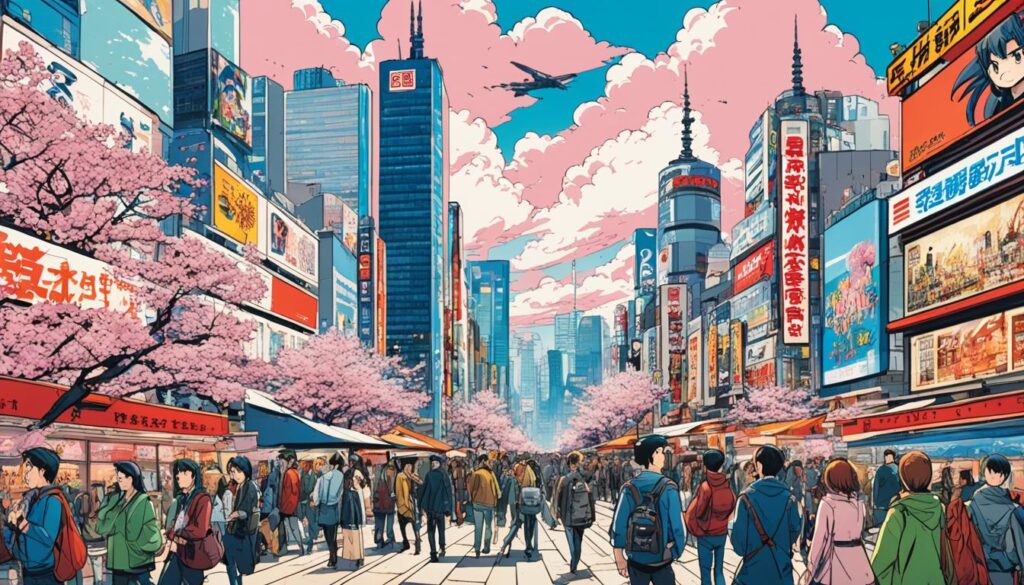
| Statistics | Key Findings |
|---|---|
| Manga Sales in France | Manga represented one in four books sold in France in 2021, amounting to €900 million in sales. |
| Manga Dominance in the US | Last year, manga comprised 76.1 percent of overall graphic novel sales in the adult fiction category in the United States. |
| Manga and Anime Symbiosis | The highest selling manga series are highly correlated with the most-streamed anime. |
| ACG and Gaming Integration | There are historical reasons for the integration of gaming into the ACG industry, such as talent influx from manga and anime studios into the video game industry in Japan. |
| Cultural Impact of Anime | Anime, Comics, Gaming (ACG) is a term popular in Greater China and Southeast Asia to encompass the business and culture formed around anime, comics, and gaming. |
| Cross-Cultural Appeal | Manga and anime have attracted a global following, allowing for cultural exchange and cross-cultural appeal. |
Societal Impact and Reflective Themes in Manga and Anime
Manga and anime truly matter in Japan. They are not just for fun but also shine a light on big social issues and Japan’s culture. They talk about work stress, family life, and history while starting important conversations. They show us life challenges and make us think about others more. These stories help us understand Japan and its people better.
Manga and anime badly want to talk about real-life struggles. They focus on things like working too much, family relationships, and big events from the past. For instance, “Welcome to NHK” looks at the loneliness and pressure to succeed in Japan. These stories make us think and feel for others facing tough times.
They also mirror Japan’s culture, mixing old traditions with new ideas. This blend shows the ongoing dispute between keeping old ways and moving forward. As we read or watch, we see and learn a lot about Japan’s unique culture.
Also, they get us to question and think deeply. Their style of drawing and telling stories moves us. People from everywhere enjoy their art because it says so much without words. Manga and anime push us to look beyond the surface and understand complex issues.
Manga and anime keep evolving to talk about society, break rules, and teach us about the real Japan.
Manga and anime are also big outside Japan. They shape global trends in music, fashion, and more. Their stories have a big fan base worldwide, leading to a lot of new art, shows, and ways to share love for them. This sharing has made people from different places feel closer to Japan and each other.
To wrap up, manga and anime make a huge impact on Japan and the world. They tell stories that-go beyond just fun, helping us know Japan and think about bigger issues. Their storytelling calls us to understand not just Japan, but the global community better.
The Economic Powerhouse of Manga and Anime
The manga and anime industries are big players in Japan’s economy. They make billions of dollars yearly. The manga industry alone made around $5.6 billion USD in 2020. More than half of this came from digital comics. This big jump is thanks to digital formats, which allow more people worldwide to read manga.
The anime industry is also soaring, driven by a high demand worldwide. In 2020, Japan’s anime exports hit over $10 billion. This shows it’s a top cultural export for Japan. Anime is getting more popular and this helps Japan’s economy and its influence on the world.
The Current and Projected Market Values
The manga industry is a big deal in Japan. It was worth almost 676 billion yen. The global manga market reached roughly USD 12.13 billion in 2021. This shows manga’s influence worldwide. It’s still growing, with the market expected to increase by 17.4% annually from 2023 to 2030.
The anime industry’s value is also going up. It was valued at USD 22.6 billion in 2020. By 2030, it’s estimated to be about USD 48.3 billion. This means the anime industry has a bright future in terms of making money.
Employment Opportunities and Economic Growth
Manga and anime provide jobs to many in Japan and beyond. This includes artists, writers, animators, and voice actors. It helps the economy at home and abroad. More manga and anime being sold means more job opportunities worldwide and stronger global connections.
Success in manga and anime leads to more investments. This can be seen in things like merchandise, streaming services, and conventions. It all adds up to more money and more jobs in the entertainment industry.
Global Cultural Influence of Manga and Anime
Manga and anime are now global icons, loved by many around the world. They tell stories uniquely, through art and animation. These stories have not just entertained; they’ve influenced global culture, including fashion, art, and even how we think.
They are so popular because they bridge different cultures. Even though they began in Japan, they have touched the hearts of people in the West. The colorful, unique style of anime is now often seen in Western films and artwork. This has helped them spread their influence far and wide.
“Anime’s influence extends beyond entertainment, permeating various facets of global pop culture.”
Manga readership around the world has grown with the success of anime. Shows like Dragon Ball Z, Death Note, and Sailor Moon, and movies from Studio Ghibli, are much-loved globally. These have made manga and anime a hit not just in Japan but worldwide.
Companies like Tokyo Pop and CrunchyRoll help manga and anime reach a broader audience by translating and distributing these works. This has been key to their success around the world.
Events like anime conventions and online streaming on services like Netflix also help. They allow fans and creators to meet and share their love for anime. This has made anime popular everywhere, helping it quickly become a global entertainment.
The Cultural Export of Manga and Anime
Manga and anime are more than just for fun; they’re cultural exports that show the best in Japanese storytelling and art. They’ve influenced more than just entertainment. They’ve also changed fashion, music, film, and language. Their unique and colorful style has inspired artists around the world.
“Manga and anime have surpassed cultural boundaries, captivating and influencing audiences worldwide.”
Manga and anime’s stories touch people globally. They cover a wide range of genres, like action, romance, and mystery. This broad appeal makes them popular with many different people.
Manga has stories for everyone, from young children to adults. This variety connects with readers of all ages and interests. It shows how manga unites people worldwide, making it a truly global phenomenon.
In conclusion, manga and anime stand out for their power to bring people together. Their stories and art have a worldwide appeal. They’ve not just changed entertainment but have also influenced our cultures.
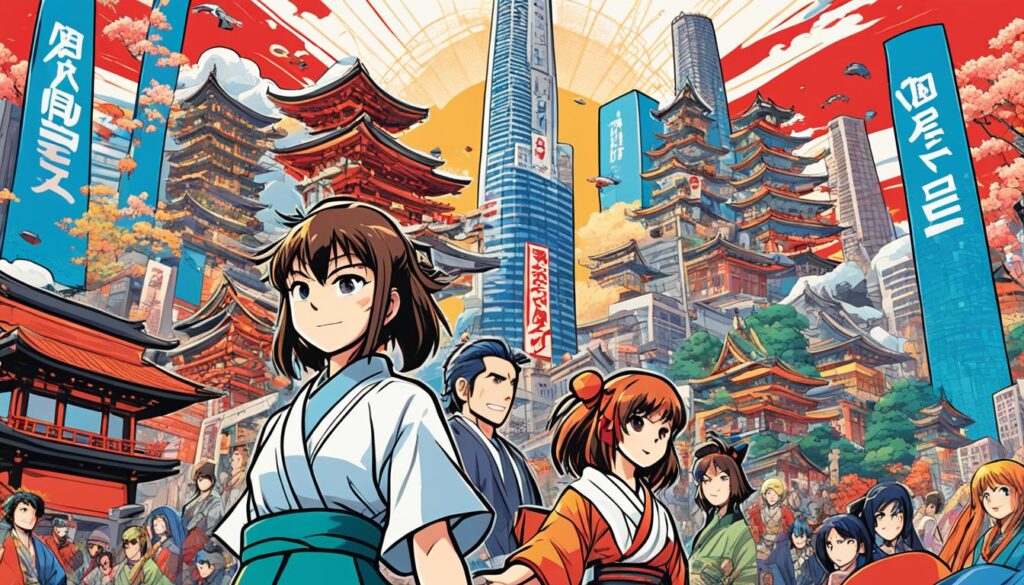
The Evolution and Artistic Qualities of Manga and Anime
Manga and anime have deep artistic roots and have evolved into unique, captivating forms of art. Manga started from traditional Japanese art like scrolls and woodblocks. This formed the basis for its storytelling and style. Anime then took manga’s stories and animated them to create new life.
Manga stands out for its detailed artwork. It features intricate designs, expressive characters, and lots of detail. This detailed work lets manga artists create worlds that pull you in and touch your emotions.
Anime, on the other hand, comes in many visual styles, from the playful to the very real. Anime’s animation adds life to stories, making them move and feel real. This combination of art and movement has made anime a powerful storytelling medium. It enchants viewers with its beautiful scenes and deep meanings.
But manga and anime are not just pretty to look at. They also tell deep stories. These stories cover many themes, from big adventures and important battles to deep thoughts about life and the world. The stories in manga and anime make the characters real, bring up big ideas, and prompt deep thinking.
“Manga and anime have evolved into powerful artistic expressions, with engaging narratives and unique visual styles that have captivated audiences worldwide.”
As time goes on, manga, and anime keep changing, adding new ways to tell stories and make art. What started with simple black and white drawings has turned into complex digital art. These changes help creators keep exploring and growing in their art. The evolution of manga and anime keeps them popular and brings in new fans.
Worldwide, more and more people are loving manga and anime. They’re not just art; they’re also a source of inspiration for people who want to create their own stories and art. Manga and anime stand out with their distinctive styles and deep stories. They are truly beloved and make a mark on the world of art and storytelling.
Issues and Challenges in the Manga and Anime Industry
The manga and anime world is loved around the globe. But, the people who make them face big hurdles. This includes the animators, illustrators, and manga artists. They often work in bad conditions and get low pay.
Freelancers in this field face a tough time too. They struggle with little work and low pay. This can hurt the industry’s future and the quality of what’s made.
There are groups working to make things better. They want to improve pay and working conditions. Trade unions fight for creators’ rights and fair rules within the industry.
The Impact of Working Conditions
Manga and anime work can be really hard on people. They often work long hours which makes them tired. In some bad cases, people work for days on end or do too much overtime.
These tough situations have led to health issues and even suicides. This is a big problem in Japan, known as “karoshi” – death by overwork.
The Struggles of Manga Artists
Manga artists, or mangaka, have their own set of challenges. They have almost no free time because of their jobs. This can lead to bad sleep and not eating right.
Some successful mangaka can hire help. But, it can still be really stressful. They often feel pressure to please their publishers and fans.
Facing Financial Hardships
It’s tough for manga artists who aren’t well-known. They only earn based on how much they work and from royalties. This can change a lot. So, some end up needing second jobs.
Even though the top publishers make a lot of money, it doesn’t always help the artists much.
The Role of Unions and Collective Action
The decrease in unions in Japan is hurting the manga and anime world. Without unions, it’s hard for artists to come together. Their work is usually just for them and can’t be done in groups.
Encouraging Positive Change
But, there are people trying to make things better. Terumi Nishii, who worked on shows like One Piece and Pokémon, is one of them. She welcomes new people to the industry. She believes they can help make things better.
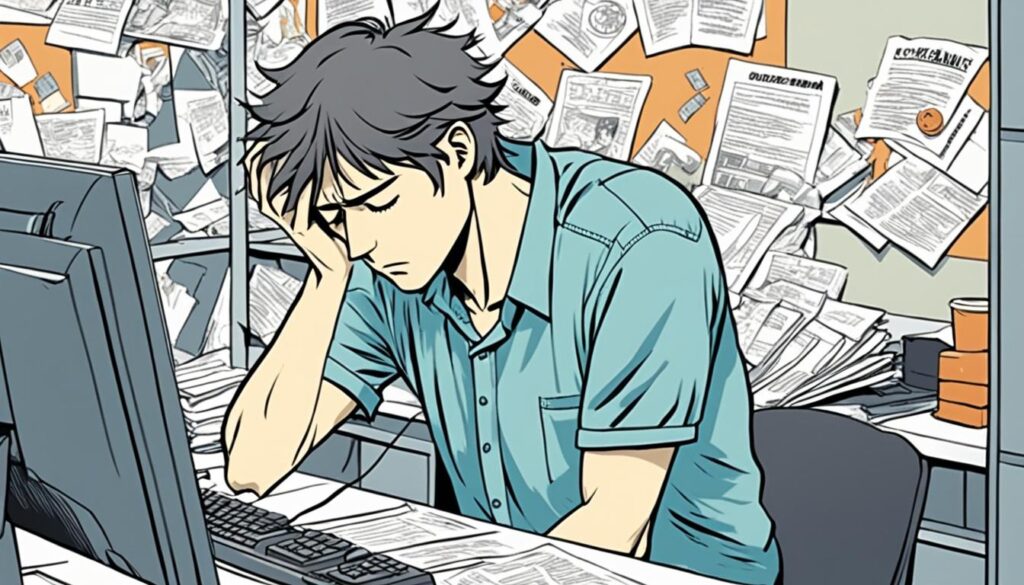
| Challenges Faced in the Manga and Anime Industry | Impact |
|---|---|
| Poor working conditions | Affected physical and mental health |
| Inadequate pay | Financial hardships for professionals |
| Extreme working hours | Increased risk for karoshi (death by overwork) |
| Intense workload for mangaka | Impacts work-life balance and well-being |
| Fluctuating income for lesser-known artists | Financial instability and need for second jobs |
| Lack of collective action and worker unions | Difficulty in addressing industry-wide issues |
The Future of Manga and Anime
The manga and anime world is about to change a lot. New technology and a wider market mean huge growth and creativity. This is setting the stage for big changes in our entertainment choices.
More people are choosing to read manga online than ever before. This means creators can share their work with a bigger crowd. In turn, this boosts creativity and brings fresh stories to fans.
Anime is also finding more fans worldwide. Thanks to online shows and global distribution, it’s becoming a hit everywhere. This surge is pushing the industry to explore new places and welcome more viewers.
We can expect even more from manga and anime soon. Tech will drive new ways to tell stories and dazzle audiences. Platforms like WEBTOON will make manga even more accessible, drawing in fresh faces.
For anime, reaching out globally will be key. As it wins hearts worldwide, more countries are teaming up to make shows and share their cultures. This broad approach will bring us more varied and interesting shows.
The horizon for manga and anime is shining bright. With growing fans, new tech, and more chances to share stories, they will stay on top. Both will keep bringing us together through tales that cross all borders.
Future Trends in Manga and Anime
| Type of Trends | Description |
|---|---|
| Digital Transformation | The shift towards digital comics and online platforms, expanding the reach and accessibility of manga. |
| Global Expansion | The growing international demand and distribution of anime, leading to the industry’s expansion into new territories. |
| Technological Advancements | Ongoing innovations in animation techniques and production technologies, enhancing the visual and immersive qualities of anime. |
| Cultural Exchange | Increased collaboration and partnerships between international production studios, fostering cross-cultural exchange and diverse storytelling. |
Influential Manga and Anime Series
Over time, several manga and anime series have become icons. They’ve had a huge cultural impact and built a global fan base. These series are known for their great stories, amazing art, and characters we can’t forget. Let’s explore some of these important series that have shaped the industry and received world-wide fame.
Dragon Ball
Created by Akira Toriyama, Dragon Ball is a manga that changed the game. It was active from 1984 to 1995. The story is about Goku and his pals collecting powerful Dragon Balls. These Dragon Balls can grant wishes.
Dragon Ball is famous for its thrilling fights and cool characters. It mixed martial arts with fantasy elements in a unique way. It became a big deal in manga and anime, influencing many adaptations like its anime, movies, games, and merchandise.
Naruto
Naruto, by Masashi Kishimoto, is another big manga. It was from 1999 to 2014. It’s about Naruto Uzumaki, a young ninja who dreams of being the strongest ninja leader.
Naruto’s story of finding friends and never giving up is loved by people of all ages. It’s known for its intense fights, detailed world, and deep characters. Naruto is a global hit, inspiring fans around the world.
Neon Genesis Evangelion
Neon Genesis Evangelion is a unique take on the mecha genre by Hideaki Anno. It aired from 1995 to 1996. It’s about teenagers who pilot giant robots to protect Earth from Angels.
This show is deep, looking into complex emotions and life. It’s liked for its smart story, complicated characters, and deep ideas. Neon Genesis Evangelion has become an important part of anime, influencing many other works.
These series are just a small part of what manga and anime have to offer. They’ve introduced many to the world of manga and anime through their great stories and characters. They’ve also inspired fans to create art and media all over the world.
| Series | Author | Years Active |
|---|---|---|
| Dragon Ball | Akira Toriyama | 1984-1995 |
| Naruto | Masashi Kishimoto | 1999-2014 |
| Neon Genesis Evangelion | Hideaki Anno | 1995-1996 |
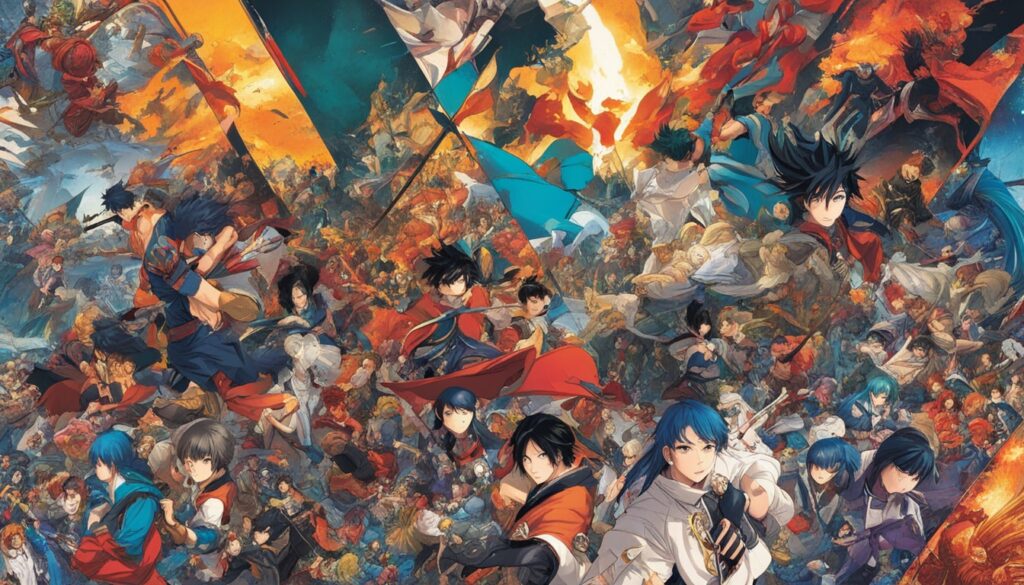
The impact of these series is huge. They still draw fans and lead the way for manga and anime. Their stories and art bring people together, no matter where they are from. Manga and anime are not just for fun; they are ways to share stories and connect people across the globe.
The Artistic Qualities of Manga and Anime
Manga and anime draw people in with their detailed images and complex stories. They also create characters that are easily recognized. These features make manga and anime beloved by many around the world.
The detailed artwork in manga and anime shows the great skill of the artists. Each part of the picture is made with care, focusing on every small detail. This makes the worlds in manga and anime come to life with color and life.
The stories in manga and anime use many ways to keep the audience interested. They use techniques like turning back in time, hinting at what’s to come, and surprises in the plot. This keeps people eager to know what happens next.
“In manga and anime, the extraordinary ability to tell stories that resonate with audiences on an emotional level is achieved through a combination of artistry and narrative techniques. The visuals and storytelling work hand in hand, creating a powerful and immersive storytelling experience.” – Anime Enthusiast Magazine
The characters in manga and anime have unique designs that stand out. They often have big eyes that show a lot of feelings. The bodies of these characters are drawn slim, following certain rules, making them very eye-catching.
Manga and anime have also influenced Western cartoons. For example, “The Powerpuff Girls” was created with inspiration from manga and anime. This mix of styles has led to new and interesting cartoons.
The impact of manga and anime goes beyond cultures and languages. Iconic shows like “Sailor Moon,” “Dragon Ball,” and “Naruto” have touched hearts all over the world. They have inspired many fans to create their own art based on these shows.
The beauty and creativity of manga and anime are truly remarkable. They continue to expand their creative limits and appeal to a wide range of people. The intricate drawings, engaging stories, and memorable characters make manga and anime stand out as works of art.
The Role of Manga and Anime in Japanese Society
Manga and anime are more than fun in Japan. They are key to Japanese culture. These art forms do more than tell stories, they shape norms and reflect the country’s history.
They are a way to talk about today’s issues. This can be anything from overworking to family dynamics. Manga and anime show the challenges Japan faces, helping people understand the country’s changes over time.
They also look at Japan’s past. Whether it’s battles or big cultural changes, these stories help people see the history in new ways. This makes Japanese history more engaging and easier to understand for everyone.
They also influence how people think and act. By showing strong characters and different relationships, they break old stereotypes. This lets people see new possibilities for themselves and their society.
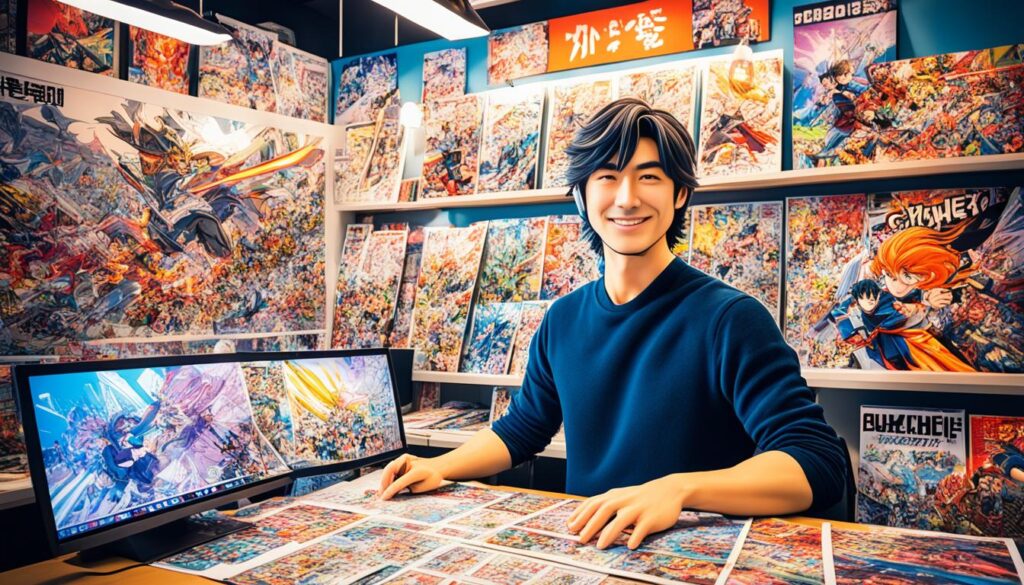
There is manga and anime for everyone. From kids to adults, there are stories for each age group. This variety means there’s something for every kind of person.
Female creators have added a lot to these art forms, like Naoko Takeuchi and Hiromu Arakawa. They’ve put new ideas into manga. This has been part of a shift toward more diverse and interesting stories.
So, manga and anime reflect and shape Japan. They entertain, but they also help people think about their culture. This makes them important to Japan’s social and historical fabric.
The Popularity and Global Reach of Manga and Anime
Manga and anime are loved worldwide. They have found fans across the globe. This is due to the wide availability of translations. The internet has helped them win a dedicated fan base far from Japan.
Their stories explore friendship, love, and adventure. This attracts people worldwide, making them global sensations. People from all walks of life enjoy manga and anime, sharing their experiences online.
Streaming platforms have also played a huge role. Services like Netflix and Amazon Prime offer a vast array of content. Now anyone can watch, no matter where they live. This has greatly expanded the audience for these art forms.
The impact of manga and anime is huge. In 2020, their combined profits hit over $15 billion. This shows how much they are cherished around the world. The fan base is only expected to keep growing.
The manga and anime industries enjoy incredible commercial success. The manga market is predicted to grow rapidly. It could be worth over $12 billion by 2030. The anime industry will also see big growth. By 2030, its value could double.
Notably, international markets play a big part in this success. This shows how much manga and anime mean to people worldwide. Their future is bright, with ever-growing technology and fans. They are truly global phenomena.
The Significance of Anime as a Cultural Phenomenon
Anime is now much more than a niche hobby in Japan. It’s a big part of entertainment worldwide. Its vibrant, detailed art style influences fashion, music, and more.
One key to anime’s popularity is its look. The bold colors and detailed scenes draw in artists and fans alike. This unique style has spread throughout pop culture worldwide.
But anime is more than just looks. It’s a way for people of different backgrounds to connect. Through sharing stories and values, it helps bridge cultural gaps.
Anime is now a huge industry, worth billions. People around the world watch it, boosting the demand for new shows and products. It affects what people buy, listen to, and wear.
“Anime has become synonymous with cultural exchange, fostering a deeper understanding and appreciation of different cultures and perspectives.”
Osamu Tezuka was a pioneer, creating Astro Boy. This series ran for over 16 years, touching on serious issues in a powerful way. Tezuka wanted anime to unite Japan, the US, and the world. Even from Astro Boy’s start, he aimed for a global impact.
Today, the anime market is strong, and it’s growing. It’s set to be worth over $50 billion by 2032. These figures show anime’s lasting effect on the entertainment world.
| Key Statistics: | Value |
|---|---|
| Global anime market valuation in 2022: | US$ 25.62 billion |
| Predicted anime market valuation in 2032: | US$ 52.99 billion |
| Compound Annual Growth Rate (CAGR) from 2022 to 2032: | 7.5% |
Japan truly loves anime, with a third of its people being regular viewers. Over 136,700 anime titles exist, showing the depth of its culture.
Many people around the world enjoy anime, from casual fans to dedicated viewers. Its broad appeal makes it a global cultural highlight.
In summary, anime is a major player in global entertainment. It brings people together, tells unique stories, and sets trends worldwide. Its impact on culture and entertainment is profound and ongoing.
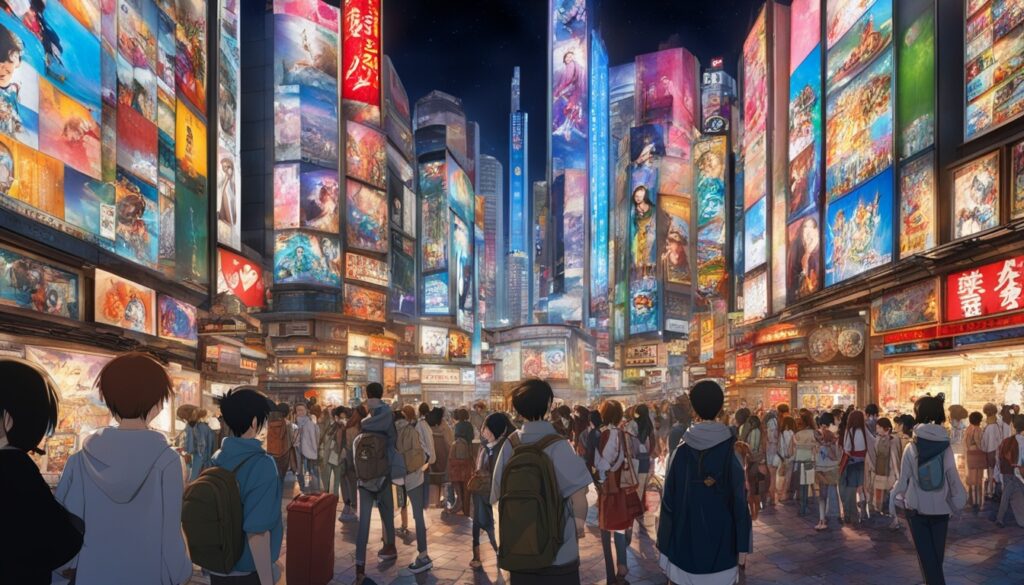
The Future of Manga and Anime Industry
The manga and anime world is growing fast, with exciting times ahead. Changes in technology and what fans like are pushing it forward. This is creating new chances for creators to shine and for fans everywhere to enjoy.
Digital manga is taking over, as more people prefer digital copies to paper. This change is good news for the manga world. In 2022, over ¥677 billion worth of manga was sold, thanks to digital formats.
The love for anime worldwide just keeps getting stronger. In 2022, its value was over USD 40 billion. Experts think it will hit USD 65 billion by 2028. This means big chances for growth and making friends across the globe.
Technology will keep on making a big difference for the industry. Studios are finding faster ways to make animation. But, some worry this could lead to too much, too fast. They fear this might lower the quality and make it all too commercial.
It used to take a year to make an anime, now it’s just three months. This faster pace and some jobs moving abroad are raising concerns. People worry it might change the anime we love, making it less unique.
The industry’s future will depend on many things like reaching new parts of the world and finding new ways to tell stories. Learning about market trends and what fans like is crucial. This info helps creators and sellers plan for what’s next.
The manga and anime universe is ready for big things. It’s a world where technology and stories meet, pulling us all closer together. These changes will make sure the love for manga and anime stays strong around the world.
Conclusion
The anime and manga industry is now a major player worldwide. It’s not just about fun. These works also talk about society, culture, and history. They help bring people together with their amazing stories.
This world is constantly growing. Anime and manga are making more money and gaining more fans all over the globe. They are now a big part of how we enjoy movies, TV, and more.
Anime and manga do more than entertain. They help mix cultures and get people talking. Many love how unique and creative they are. This helps more people understand Japan and its culture.
As tech gets better, anime and manga will only get more popular. This shows just how much people enjoy their stories and art. Their global success proves how well they connect us all.
FAQ
What is the anime industry?
The anime industry is about making, sharing, and watching Japanese cartoons called anime. It involves making the animation, creating stories from comics (manga), selling related things, and letting others show anime around the world.
What is the manga industry?
The manga industry is all about making, printing, and spreading Japanese comic books called manga. This world includes manga creators, publishers, those who deliver the books, and the now very big digital market.
What impact has anime had in America?
In America, anime has become very popular and is considered mainstream entertainment. It’s changed American media and sparked big fan communities, all with its special stories and looks.
Who is Osamu Tezuka?
Osamu Tezuka is known as the “god of manga”. He was very key in making both anime and manga. His work, like Astro Boy, made anime loved in Japan and later in America too.
How has manga and anime achieved international popularity?
Manga and anime explore many themes and have very engaging content. This makes them fun and interesting for people worldwide. They talk about deep topics and their unique looks attract many fans, making them big parts of global storytelling.
What societal issues do manga and anime address?
Manga and anime offer a way to talk about and think on real-life issues. They deal with things like too much work, life in families, and past events. They offer understanding and insight into these matters, especially in Japan.
What is the economic impact of manga and anime?
Manga and anime bring in lots of money each year, helping Japan’s economy a great deal. The digital manga world and the want for anime outside Japan keep making it grow. This creates jobs and helps increase Japan’s GDP.
How have manga and anime influenced global culture?
Manga and anime have left marks on global culture in areas like fashion, art, and thinking. They’ve found their way into many Western films and TV shows. Now, they’re seen worldwide as much-loved modern types of stories.
What are the challenges faced by professionals in the industry?
People who work on manga and anime can have hard jobs and not get paid much. This is especially true for those who work alone. It makes people worry about the future and about needing to get help from other countries to make the shows and comics.
What does the future hold for manga and anime?
Manga and anime are moving into the digital world more and becoming more popular outside Japan. The demand for Japanese animations globally is growing. This means new chances for the people who make these stories and even more interesting ways to tell them.
Which manga and anime series have had a significant cultural impact?
Series like “Dragon Ball,” “Naruto,” and “Neon Genesis Evangelion” are now culture icons. They’ve drawn in big audiences around the globe with their stories, looks, and characters. These series have not just influenced the manga and anime world, but also the general culture space.
What are the artistic qualities of manga and anime?
The great drawings, deep stories, and unique characters are what make manga and anime so liked worldwide. Their ability to make beautiful, touching stories makes them more than just stories. They are ways to express art that everyone can understand and enjoy.
What role do manga and anime play in Japanese society?
In Japan, manga and anime are big parts of who they are and what they care about. They mirror and shape everyday life, values, and history. By looking at modern issues and traditional events, they help everyone understand Japan’s journey better.
How popular are manga and anime globally?
Manga and anime have become very loved all over the world thanks to translations and sharing. People from all over find their messages and stories interesting. They are loved for how well they tell universal stories that touch everyone.
Why is anime considered a cultural phenomenon?
Anime is a big part of culture with a huge impact all around the world. It brings people together and opens their minds with stories and art that everyone likes. It’s known for its special way of telling stories and showing things, influencing many parts of today’s culture.
What does the future hold for the manga and anime industry?
The manga and anime world is growing and changing in good ways. It’s moving a lot onto digital platforms and more people outside Japan want to see anime. As new tech and ways to share stories come out, there’s a lot of chances for those who make them to do new and exciting things.
Source Links
- https://aleccowan12.medium.com/how-anime-took-off-in-the-u-s-8d6354557867
- https://www.linkedin.com/pulse/introduction-manga-anime-understanding-roots-global-reach-muqadim-cf6if
- https://en.wikipedia.org/wiki/History_of_anime_in_the_United_States
- https://www.fandom.com/articles/anime-history-america
- https://www.thenation.com/article/culture/manga-hulks-its-way-to-the-top/
- https://naavik.co/deep-dives/understanding-anime-aesthetics/
- https://fulcrum.sg/aseanfocus/the-courteous-charmer-a-hard-look-at-japans-soft-power-in-southeast-asia/
- https://medium.com/@jhoelfransis/the-art-of-manga-unveiling-its-influence-on-society-f60f789aaaf8
- https://moreby.us/anime-a-reflection-of-japanese-culture/
- https://apjjf.org/2017/09/oguma
- https://www.japanhousela.com/articles/the-impact-of-manga-and-anime/
- https://medium.com/@cristifrncu/inside-the-anime-world-the-influence-and-globalization-of-japans-vibrant-art-form-28509554c974
- https://medium.com/the-crown-writer/the-evolution-of-anime-17076b4accea
- https://medium.com/@patrickmacias/how-to-save-the-anime-industry-from-itself-45ac38c0c0c8
- https://www.leftvoice.org/exploitation-in-storytelling-the-conditions-of-manga-artists-in-japan/
- https://www.equaltimes.org/anime-and-manga-creators-dream
- https://www.linkedin.com/pulse/anime-market-landscape-future-trends-industry-4hu7f
- https://screenrant.com/webtoon-best-manga-manhua-industry-future/
- https://www.cbr.com/influential-manga-creators-shaped-industry/
- https://bookriot.com/most-influential-manga-of-all-time/
- https://www.domestika.org/en/blog/6879-what-are-the-key-characteristics-of-manga-illustration
- https://washiblog.wordpress.com/2011/01/18/anime-production-detailed-guide-to-how-anime-is-made-and-the-talent-behind-it/
- https://www.britishmuseum.org/blog/introduction-manga
- https://www.insidejapantours.com/japanese-culture/manga-and-anime/
- https://www.dentsu.co.jp/en/showcase/anime_is_killer_content.html
- https://goldenglobes.com/articles/exploring-global-phenomenon-anime-japan-world
- https://openjicareport.jica.go.jp/pdf/11623238_02.PDF
